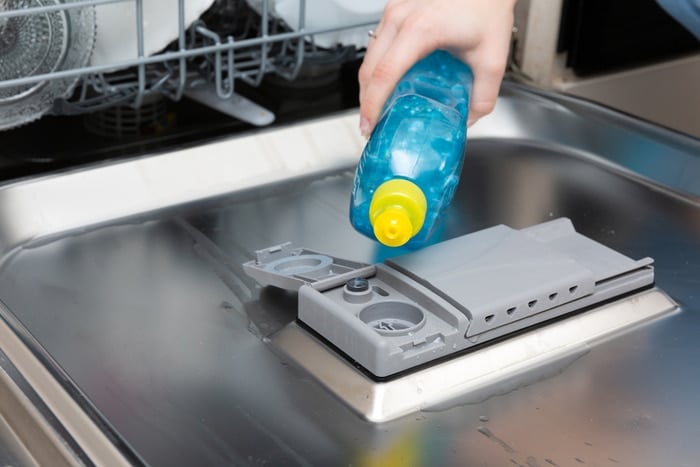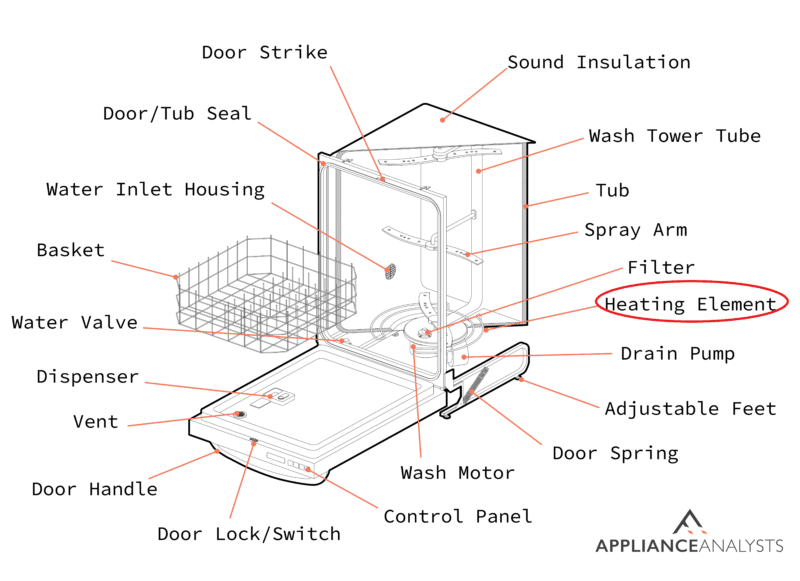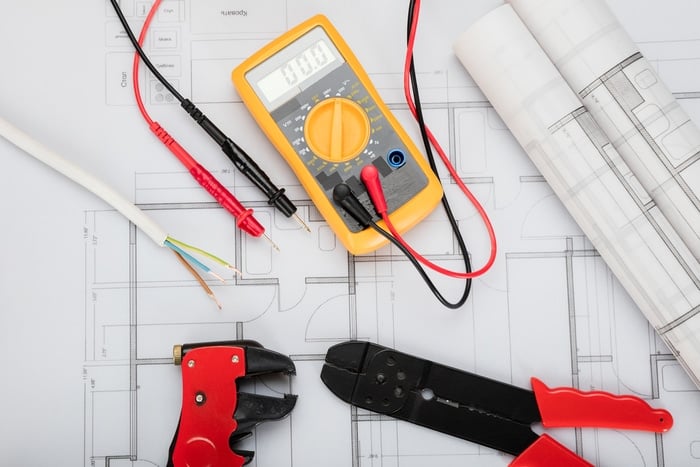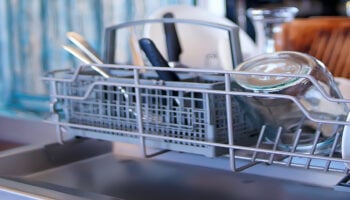We've independently reviewed this article to make sure it's as accurate as we can make it.
To find out more about our article creation and review process, check out our editorial guidelines.
Stuck trying to figure out why your dishwasher stays wet inside?
Sadly, I’ve been there too. There’s nothing more frustrating than opening your dishwasher only to find that the dishes are still wet.
But don’t worry. The good news is that you’ve come to the right place for answers.
If your dishwasher is always wet inside, chances are the heated drying setting is disabled, you didn’t use a rinse aid, or it is overloaded. Not leaving the door open after every cycle and having a faulty heating element could also explain the issue.
Keep reading to learn how to stop your dishwasher from always being soaking wet!
This article was written in collaboration with two appliance repair experts: James Blackford & Andy Fulencheck. We have over 25 years of combined appliance repair experience – please see our profiles to learn more about our backgrounds.
Is Your Dishwasher Not Drying? Try These 8 Simple Fixes
You wouldn’t believe how many people I’ve seen complain about having a dishwasher that is always waterlogged.
It’s important to note that there will be some residual water in all dishwashers after a cycle, although high-end models handle this more effectively.
However, if you find that the issue persists significantly, please check the following factors:
#1 Check Your Settings
I’ve observed that dishwashers can have problems drying if the correct setting is not selected.
You see, dishwashers have a heated drying cycle that forces hot air inside to remove moisture from your dishes.
Some dishwashers automatically turn off the heated dry setting because it adds 30 minutes to your washing cycle and increases your energy consumption.
If you’d like to stop your dishwasher from always being wet, I recommend enabling the heated drying cycle by pressing the “Heated Dry” button (it is usually located in the control panel).
Please bear in mind that according to Atlantic Coast Appliance, this setting can increase your energy consumption by at least 15%.
If your appliance doesn’t have a heated drying setting, don’t worry! Keep reading to learn other ways to stop your dishwasher from always being wet inside.
#2 Use a Rinse Aid
In my experience, if your dishwasher is still very wet after a wash, your rinse aid dispenser is likely empty.
You see, rinse aids not only prevent water spots, but they can also make your dishes dry faster. Like Rain-x on a windshield, rinse-aid helps water bead/shed off the dishes more efficiently – and so dry faster.
I recommend opening the rinse aid dispenser and removing the cap. Then, use a turkey baster to remove any liquids left and rinse with water.
Cleaning the dispenser will also help you eliminate any blockages that prevent your rinse aid from getting to your dishes and causing your dishwasher to stay wet inside.
Then, please pour the rinse aid until it reaches the max line.

#3 Use Hot Water
Your dishwasher will remain wet inside and won’t dry your dishes if you don’t use the proper water temperature.
In my experience, the hotter the water during the wash cycle, the better the drying results for your dishes.
The easiest way to ensure you’re using the correct water temperature is by turning on the hot water at your kitchen sink and checking if it reaches around 120ºF.
If you don’t have a thermometer handy, you can estimate the water temperature by briefly placing your hand under the running water. If it feels too hot, and you need to pull it out after a second or two, it’s likely that the temperature is around the desired range.
But, if your dishwasher is always soaking after a cycle, or not heating the water, please check the heating element.
#4 Check the Heating Element
If the heating element is not working, your dishwasher will stay wet inside and won’t dry your dishes effectively.

You can quickly test the heating element with a multimeter, which measures the electric current, voltage, and resistance.

- Unplug your dishwasher from the power source and pull it out to access the heating element.
- Remove the wires attached to the heating element. You’ll need to lie on the floor, so if you cannot do it, please ask someone for help.
- Set your multimeter to the resistance setting. Then, touch each probe to the terminals.
You should get a reading between 4 and 14 ohms (or the one recommended by the manufacturer).
If you’re not getting the recommended reading, then the heating element is causing your dishwasher to always be damp ay wet inside, and you need to replace it. Heating elements typically cost around $20 to $50*
*The cost will vary depending on your dishwasher’s model.
If you want to get any replacement part – or see how much one would cost – click to enter your model number in the search bar below. Our partners at AppliancePartsPros stock almost every part with free guides on how to install them.

#5 Don’t Overfill Your Dishwasher
If your dishwasher is always wet inside and not drying your dishes evenly, you’ll need to ensure it’s loaded correctly.

Try these tips to keep your dishwasher from always being wet:
- Make sure your dishes and cutlery are not touching each other.
- Face your dishes toward the center and avoid blocking the soap dispenser or spray arms with large pans or bowls. It’s best to place large items at the back.
- Angle dishes downward. By doing this, the water will drain, and your dishes will dry evenly.
- Place the plastic dishes on the top rack to keep them from melting. Keep in mind that plastic can remain wet while ceramic and glass dishes are dry. You’ll likely need to manually dry the plastic dishware.
- Make sure you unload the bottom dishes first. This way, the remaining water on the top racks won’t wet your dishes.
#6 Open Your Dishwasher
In my experience, one of the most effective ways to stop your dishwasher from getting too damp is by opening the door after each cycle.
You see, your dishwasher uses hot water on the wash cycles. So, if you don’t open the door, the residual steam will be trapped inside, and your dishes will become wet again.
Especially in more humid climates, your dishwasher’s tiny vent fan isn’t able to move enough air to dry the dishes. Opening the door is the best way to dry the dishes quickly.
#7 Check the Thermal Fuse
If you’ve tried all the fixes above, but your dishwasher is still wet inside, then you need to check the thermal fuse.
The thermal fuse is a safety device that keeps your appliance from overheating. However, if it’s defective, your dishwasher’s heating element will be shut off before your dishes get dry.
Test the thermal fuse at room temperature. Here’s how to do it:
- Unplug your dishwasher from the wall outlet.
- Remove the bottom panel and check the bottom of your dishwasher tub. You should be able to see the high-limit thermostat.
- Carefully disconnect the wires attached to the high-limit thermostat. Then, remove the piece from your dishwasher.
- Use a probe to touch one of the thermostat’s terminals and a different probe to touch the other terminal.
- If the reading shows 0, the high-limit thermostat is working correctly.
If the reading shows a different number, the thermostat needs to be replaced.
You can also test the thermostat’s response to temperature change by repeating the process above but placing the thermostat on an electric griddle. The multimeter’s needle should stay at 0.
Bear in mind that if the thermal fuse is damaged, it’s often a sign of a deeper problem. The fuse is only there to protect your dishwasher – whatever caused it to blow is the issue. This often needs a professional to investigate and repair, which can end up getting quite costly.
#8 Make Sure the Vent Fans are Working Correctly
If your dishwasher is still not drying out, then you’ll need to check the vent fans.
The vent fans are in charge of releasing hot air. So, if they’re stuck, won’t open, or are simply undersized, your dishwasher will stay wet.
If your dishwasher used to work fine, but the vent fans appear damaged, you’ll need to replace them. This process will vary depending on your dishwasher’s model.
If you want to get any replacement part – or see how much one would cost – click to enter your model number in the search bar below. Our partners at AppliancePartsPros stock almost every part with free guides on how to install them.

But if you have a brand-new dishwasher that seems to be more wet than dry – there’s a good chance you have an undersized vent fan.
If so, open your dishwasher’s door as soon as the cycle is finished. Using a floor fan to circulate air through your dishwasher can also help.
For more tips on how to get the most out of your dishwasher and prevent performance issues, I recommend checking out our Dishwasher Maintenance & Care Guide.
Conclusion
Hopefully, now that we’ve covered everything, you’ll be able to stop your dishwasher from always being wet.
If you take anything away, remember to check your settings, use a rinse aid, and open your dishwasher’s door after every cycle.
Don’t forget to check the heating element and vents and replace them if they’re damaged.
Thank you so much for taking the time to read this article. If you found it helpful, please check out our related content below.







